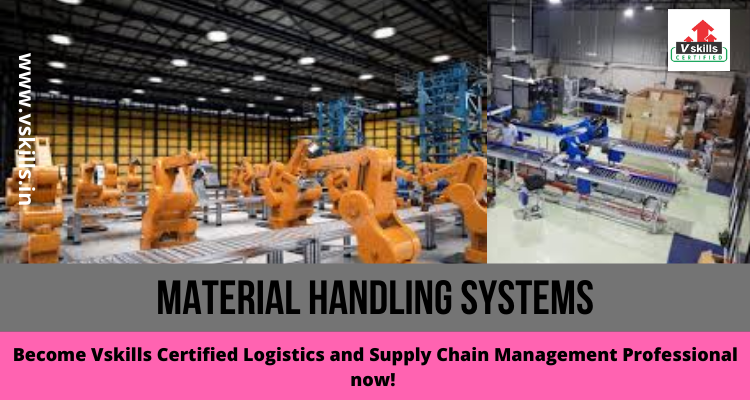Material handling systems are classified as per the type of handling equipment being used, material handled, the methods and the functions performed.
- Equipment-oriented systems, on the basis of equipment type being used:
- Overhead Systems
- Conveyor Systems
- Tractor Transfer systems
- Fork-lift Truck and Pallet Truck Systems
- Industrial Truck Systems
- Underground Systems
- Material-oriented systems, on the basis of equipment type being used:
- Unit Handling Systems
- Bulk Handling Systems
- Liquid handling Systems
- Method-oriented systems, on the basis of equipment type being used:
- Manual Systems
- Automated or Mechanized Systems
- Job-Shop Handling Systems
- Mass Production Handling Systems
Function-oriented systems, on the basis of equipment type being used:
- Transportation Systems
- Conveying Systems
- Transferring Systems
- Elevating Systems
Further, these materials handling equipments are classified into four fundamental types, namely, conveyors, cranes and hoists, trucks and auxiliary equipment.
Types of Material Handling Systems
Conveyors – Conveyors are gravity devices, used to move loads from one point to another over fixed paths. Belt conveyor, chain conveyor, roller conveyor and pneumatic conveyor are most common forms of conveyors used for handling materials in an organization. Belt conveyor is a motor-driven belt, made up of rubber or metal fabric on a fixed frame. Chain conveyor is a motor-driven chain that can drag materials alongside a metal slide base. Roller conveyors are boxes that roll up on a series of rollers mounted on a fixed frame. Pneumatic conveyor enables high volumes of air flows through a tube to carry materials alongside the airflow.
Other types of conveyors that can be used for material handling are screw conveyor, bucket conveyor, vibratory conveyor, pipeline conveyor, gravity conveyor and trolley conveyor. The most useful thing about using conveyors is that they do not need operators to move huge volumes of products, and are also quite cost-efficient to operate.
Cranes, Elevators and Hoists – Cranes, elevators and hoists are referred to as overloaded devices, which are generally used in organizations to move various loads from time to time amid points fixed by supporting and binding rails within an area. Cranes are mounted on ground level rails or wheels or on overhead rails, such that they lift, swing and move heavy and large materials. Jib Crane, Gantry Crane, and Electrically Operated Overhead Crane (EOTC) are common examples of cranes. Elevators, on the other hand, are another form of cranes that are used to lift materials generally between floors of buildings. Hoists are the devices that can transport materials horizontally and vertically in a limited area. Electric hoists, chain hoists and air hoists are good examples of hoists used in many organizations.
Industrial Trucks – Industrial trucks can move similar or mixed loads sporadically over different paths, such as electric, gasoline or liquefied petroleum, diesel, gas powered vehicles equipped with beds, forks, arms or other holding devices. Some commonly used industrial trucks include forklift trucks, tractor with trailers, power trolleys, pallet trucks and hand trucks.
Auxiliary Equipments – These equipments or devices are used with handling equipment to give an effective and versatile result, such as pallets, positioners, ramps, turn-tables and containers.
Other Material Handling Systems
- Pipelines – Pipelines refer to closed tubes that enable transportation of liquid materials through use of pumps or gravity.
- Atomized Transfer Devices – These devices have the capacity to grab hold of materials automatically in a firm state, during the operational stage itself, and thereafter move them to the desired locations.
- Automated Guided Vehicle (AGV) Systems – The AGV systems offer extreme flexibility on the paths they travel, on their functions and are controlled through signals made via wired embedded in the floor or induction tape on the floor space. AGV movements can ideally be controlled by a remote control computer.
- Industrial Robots – This mechanism has a movable arm-like projection similar to a gripper at the bottom, used to perform control functions which can be reprogrammed and therefore, they are quite versatile.
Both the process design as well as the principles of efficient materials handling provide the framework to select specific materials handling equipments to form the basis of materials handling system. Each of the material handling equipments has their own salient features, and benefits and drawbacks.
Material Handling Practices
The first rule of effective material handling is the supervisor’s responsibility towards the operations to ensure that the workers under his control are given instructions to execute safety precautions. And therefore for which the supervisor needs to hold working knowledge about the safety precautions and that he or she should ensure that all workers are properly trained in material handling practices, particularly in the following areas:
Safety knowledge and training: Workers should be instructed and made aware of any potential dangers related to their tasks and trained on how to avoid hazards that can further assist in reducing the frequency of accidents while they are at work.
Knowledge on hazardous materials: Flammable articles, acids, chemicals and the like materials need utmost care and attention in comparison with other items. The material characteristics being stowed will indicate the care and attention needed to be careful about potential hazards and risks. Workers engaged with handling hazardous materials should possess good knowledge about all potential hazards and dangers related to these materials.
Equipment Design: The equipment is designed such that it is able to perform the desired function it has been designed for. Potential hazards may appear if the equipment selected for operational use is being used for the purpose other than for which it has been designed, or for an operation beyond the rated capacity.
Maintenance: Equipment if kept in improper conditions could pose a hazard to the organization. Operators should be instructed properly on the maintenance requirements and not to operate equipment that appears to be mechanically risky to run.
Attachments: Workers should be trained on how to use all attachments on all kinds of equipment, including various potential hazards associated with the use of such equipment.



